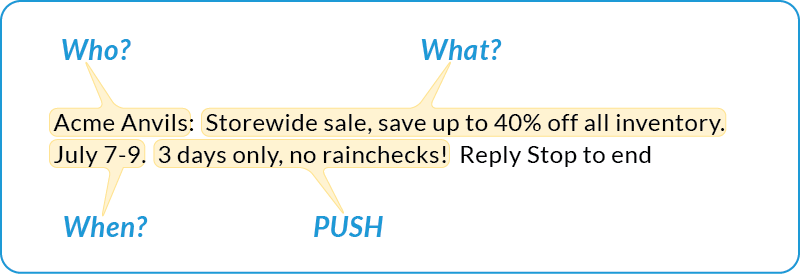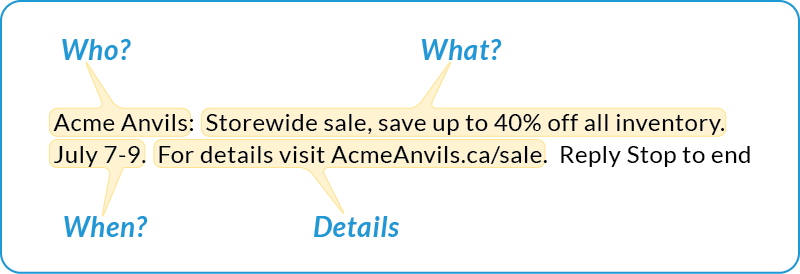How to Write Great Text Messages (for Your SMS Campaigns)
Table of Contents
Introduction
SMS / text message marketing is a powerful, compelling marketing channel that bypasses the noise and clutter of email and social media and delivers your message via the medium reserved for your customer’s immediate social circle and closest friends.
But crafting compelling marketing messages with 160 characters or less can be challenging.
This article will show you how to write great text messages for your SMS campaigns using a couple of proven templates and examples, plus I’ll provide some context as to what people’s expectations are when it comes to text messages in general.
I hope you find it useful.
Note: For those you who do not want to be restricted to 160 characters, we also offer the ability to send promotional MMS (which includes an image plus 480 characters of text), which provides much more flexibility for your messaging.
A Little Context to Start
In my experience, one of the reasons people struggle with crafting SMS marketing messages is that they fail to see texting as its own “unique channel” and instead, view it as a sort of “character restricted” email newsletter.
It’s almost impossible to write great text messages if you approach them the same way as you approach an e-newsletter.
You simply do not have the characters to do so. Approaching them this way also fails to recognize that…
- Text messaging is a much less formal messaging channel than email.
- Short, direct messages—even to the point of being curt—are expected, even appreciated, in texts.
- Your customers have no expectation of creativity or artistic prose in text messages.
While your email newsletter might be artsy and articulate, your text messages will be anything but… you need to “cut the fat.” Once you get your head around this, it becomes much easier!
Just the Facts, Ma’am!
Another thing an email newsletter allows you to do is highlight your promotions in detail, perhaps by featuring a number of the items you are discounting, often in significant detail.
In a text message, you don’t have the luxury of doing this. You also don’t have the space to discuss the quality and craftmanship that makes your clothing line far superior to your competitors’.
You can’t discuss how your grass-fed, sustainably-raised, free-range chicken is far superior to grocery store fare.
There’s little room to mention that your fanatical commitment to customer satisfaction is why 9 out of 10 people choose you over a competitor.
And so on and so on and so on.
Instead, you have to summarize the major highlight(s) of your promotion in a few words. Everything else has to go.
Determine Your Most Wanted Response (MWR)
Promotional channels like email newsletters, social media posts or print fliers allow for multiple “calls to action” in the same message.
In a text message, this is a rare luxury indeed. You will rarely have the space in a 160-character message to your customer to take more than a single action. So…
Before you craft your first marketing message you must determine…
What is my MWR (Most Wanted Response) for this campaign? In other words, what is it that I most want my customer to do after reading this text? Is it…
- Clicking a link?
- Visiting a web site?
- Visiting a physical location and making a purchase?
- Redeeming a coupon?
- Leaving a Google or Yelp review?
- Referring a friend?
Once you know what it is, this becomes the focus of your message.
And while having a single MWR may seem like a disadvantage, it can be a benefit in that it focuses your recipient’s attention.
Multiple calls to actions on the other hand, can dilute the effectiveness of a promotional campaign, distracting your customer and diverting their attention in different directions, possibly causing “paralysis by analysis.”
A single one does the opposite.
Text Messaging Template #1 (3WP)
With the background information out of the way, let’s get to the nitty gritty of write great text messages by discussing the first text messaging marketing template, which I call… 3WP or “Who, What, When, PUSH.”
The first 3 elements of the message are mandatory, and the 4th—”PUSH”—is optional.
Let’s have a look at the template and then break it down…

While most of this is pretty self explanatory, let’s go through it…
Who (Acme Anvils):
Immediately identifies the sender of the message.
What (storewide sale, save up to 40% off all inventory):
Lays out the offer; quickly tells the customer “what’s in the for them.”
When (July 7-9):
It’s very important that your campaigns include a date. Not only does this prevent you from having to deal with irate customers who visit your business only to find they missed your sale by a day, the date itself acts like a small, additional PUSH—it’s essentially an expiry date for the promotion.
PUSH (3 days only, no rainchecks):
A PUSH is pretty much what it sounds like it is—a gentle nudge that further motivates your customer to take immediate action on this offer. You should use a PUSH if space allows.
In addition to “no rainchecks”, other common PUSH statements include: “limited quantities”, “first come, first served”, “sells out fast”, “supplies limited”, “lowest prices of the year” “don’t miss it”, etc.
Mandatory opt out:
It is required by law that your messages provide instructions to your customer on how to “unsubscribe” from future messaging.
Most text marketing services (like our BROADCASTsms mass texting service) will append this content to all outgoing messages so you don’t need to worry about including it in your content.
However, you do need to be aware of the characters it adds to your message.
To create your own messages using this template you simply swap out the details of the “Acme Anvils” promo for your own…
YOUR business/brand > YOUR concise offer > date or duration of promotion > YOUR PUSH > Mandatory opt out.
Don’t worry if your message isn’t inspirational or exciting… it’s not supposed to be.
Text Messaging Template #2 (3WD)
The second template, I call 3WD, or… “Who, What, When, DETAILS.”
It is very similar to the first one, except we’re replacing the PUSH with DETAILS (also optional). Let’s have a look at the template and break it down…

We’ve been through most of the details of this template already…
Who (Acme Anvils):
Immediately identifies the sender of the message.
What (storewide sale, save up to 40% off all inventory):
Lays out the offer; quickly tells the customer “what’s in the for them.”
When (July 7-9):
It’s very important that your campaigns include a date. Not only does this prevent you from having to deal with irate customers who visit your business only to find they missed your sale by a day, the date itself acts like a small PUSH—it’s essentially an expiry date for your promotion.
DETAILS (visit AcmeAnvils.ca/sale):
DETAILS is exactly what it sounds like it is—an additional resource where the customer can get more information about your campaign/promotion.
This might be a link to your web site, a social media page, or a reference to an upcoming email newsletter or print flyer.
Mandatory opt out:
It is required by law that your messages provide instructions to your customer on how to “unsubscribe” from future messaging.
Most text marketing services (like our BROADCASTsms) will append this content to all outgoing messages so you don’t need to include it in your content. However, you do need to be aware of the characters it adds to your message.
To create your own messages using this template you simply swap out the details of the Acme Anvils promo for your own…
YOUR business/brand > YOUR concise offer > date or duration of promotion > YOUR DETAILS > Mandatory opt out.
Getting Creative: Make It Your Own
These templates are a great starting point for your text message promotions and they’ll work very well for you. You may decide never to deviate from them.
And that’s totally fine.
However, they can be considered a starting point for your messages – you can slice and dice them to your heart’s content to make them work for you.
For example, here’s an message based on Template 1 where the “PUSH” is removed entirely so that as much space as possible can be devoted to highlighting the sales items…
Chloe’s Closet: save up to 40% on kids’ pants, tees, sandals & swimwear, 25% off men’s & ladies’ jeans & shorts. July 1–3. Reply Stop to end. (158 characters).
Here’s another example. The “What?” in Template 2 has been cut back to provide as many characters as possible for DETAILS…
Chloe’s Closet: Big annual blowout sale is July 7–9. See our weekly flier or check our email newsletter for full details. Reply STOP to end (159 characters).
One last example. In this one, I use both DETAILS (“see our flier for details”) and a PUSH (“Don’t miss our lowest prices of the year!”) in the same message…
Chloe’s Closet: Big annual blowout sale is July 7–9. See our flier for details. Don’t miss our lowest prices of the year! Reply STOP to end. (158 characters).
See how it works? Of course, you don’t have to “go” here yet.
Use the two templates I have presented until you are comfortable writing promotional 160-character text messages.
When you are, feel free to deviate a bit to provide additional flexibility to your messages.
Now you know how to write great text messages! Good luck!
A note about grammar in text messages… texting is an informal channel, much less rigid than email or social media. And while you don’t want your promotional messages to look like they were written by an illiterate teenager, it’s OK to trim off an apostrophe here and there, replace “and” with “&” and use common short forms when you need a few extra characters to squeeze out your preferred message.

